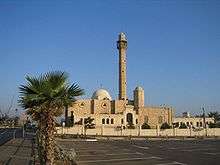Hassan Bek Mosque
| Hassan Bek Mosque | |
|---|---|
 | |
 Shown within Israel | |
| Basic information | |
| Location |
|
| Geographic coordinates | 32°03′59.09″N 34°45′48.57″E / 32.0664139°N 34.7634917°ECoordinates: 32°03′59.09″N 34°45′48.57″E / 32.0664139°N 34.7634917°E |
| Affiliation | Islam |
| Architectural description | |
| Architectural type | Mosque |
| Architectural style | Ottoman style |
| Completed | 1916 |
| Specifications | |
| Dome(s) | 1 |
| Minaret(s) | 1 |
The Hassan Bek Mosque (Arabic: مسجد حسن بك), also known as the Hasan Bey Mosque, is one of the most well-known mosques of Jaffa, a city in Israel. It has been a site of much controversy, as demonstrated in recent years.
The Hassan Bek Mosque was built in 1916 at the northern boundary of Arab Jaffa and its history is closely bound up with the various stages of the Arab-Jewish conflict, from its beginnings as a communal strife under Ottoman and British rule and up to the present. It has been on various occasions the subject of heated debate and eventful controversy, and has a deep symbolic and emotional meaning to Jaffa Muslims.
Its Ottoman-style architecture contrasts sharply with the contemporary modern high-rises situated near it. It is located between Neve Tzedek neighbourhood and the Mediterranean Sea, on the fast road to Jaffa.
History & Construction
The Hassan Bek Mosque was built in 1916, by Jaffa's Turkish-Arab governor of the same name. At the time, Jaffa and the recently founded Tel-Aviv were both competitively expanding. The mosque was part of Manshiyya, Jaffa's northernmost neighbourhood which spread northwards along the Mediterranean seashore.
The governor of Jaffa who had the mosque built is named as Hassan Bey or Bek, or Hassan Bey al-Basri al-Ghabi. Hassan Bey headed Jaffa between August 1914 and May 1916.
The mosque was built on a plot of land selected and bought by Hassan Bey from its Arab owner.
1948 war
The mosque's minaret was often used by Arab snipers to shoot at Zionist forces in Tel Aviv and Manshiya, in the months preceding the British withdrawal (no citation).
1979 war
The outcome was that the real estate deal was cancelled and the mosque returned to the hands of the Jaffa Muslim Community.[1]
Minaret collapse and reconstruction
The authorities gave permission for the Jaffa Arabs to restore the minaret, using volunteer work and funds provided by the governments of Jordan and Saudi Arabia. This is considered by Jaffa Arabs an important milestone in their recovered self-awareness and assertiveness in defence of their communal rights.
The reconstructed minaret is twice as tall as the original one.
Up to the present, Jaffa Arabs maintain an ongoing presence in the renovated mosque, and prayers are held in it regularly, though it is a considerable distance from the neighbourhood where the Muslim community of Jaffa is living.
Second Intifada
On June 1, 2001, a suicide bombing by the militant group Hamas occurred nearby at the nearby Tel Aviv Dolphinarium dance club, claiming the lives of 21 Israelis, the majority of them teenage girls.
Description
The Ottoman-style mosque initially measured 21 by 28 metres, was well-proportioned and fit well into the Al-Manshiya neighbourhood.[2] It had a courtyard partially paved and in part used as a garden; the prayer hall was entered by a staircase on its northern side.[2] In 1923 the mosque was already the object of politically motivated renovations ordered by the Supreme Muslim Council,[2] and its overall area was substantially expanded in the 1980s.[3]
The mosque employs a white limestone instead of using the more common stone of the area, kurkar, a yellow-brown calcareous sandstone. The walls of the mosque are perforated with intricately decorated and colourfully glazed windows. The walls are also refined by narrow engaged piers that divide the wide façades into smaller sections.
The current minaret was rebuilt at twice its original height as part of the renovation in the 1980s; extremely tall and slender, it contrasts with the square prayer hall. A very low tower rises on the opposite side of the mosque. The concrete roof is flat and proportionally low, with a shallow dome over the central bay.[3]
Gallery
 Bird's-eye view of the mosque from southeast
Bird's-eye view of the mosque from southeast
References
- ↑ Nimrod Luz, The Politics of Sacred Places. Palestinian Identity, collective memory, and resistance in the Hassan Bek mosque conflict, Environment and Planning D: Society and Space, 2008
- 1 2 3 Marshall J. Breger, Yitzhak Reiter, Leonard Hammer (editors), Holy Places in the Israeli-Palestinian Conflict: Confrontation and Co-existence, chapter "The making of a landmark"
- 1 2 Hasan Bek Mosque on Archnet digital library
| Wikimedia Commons has media related to Hassan Bek Mosque. |
